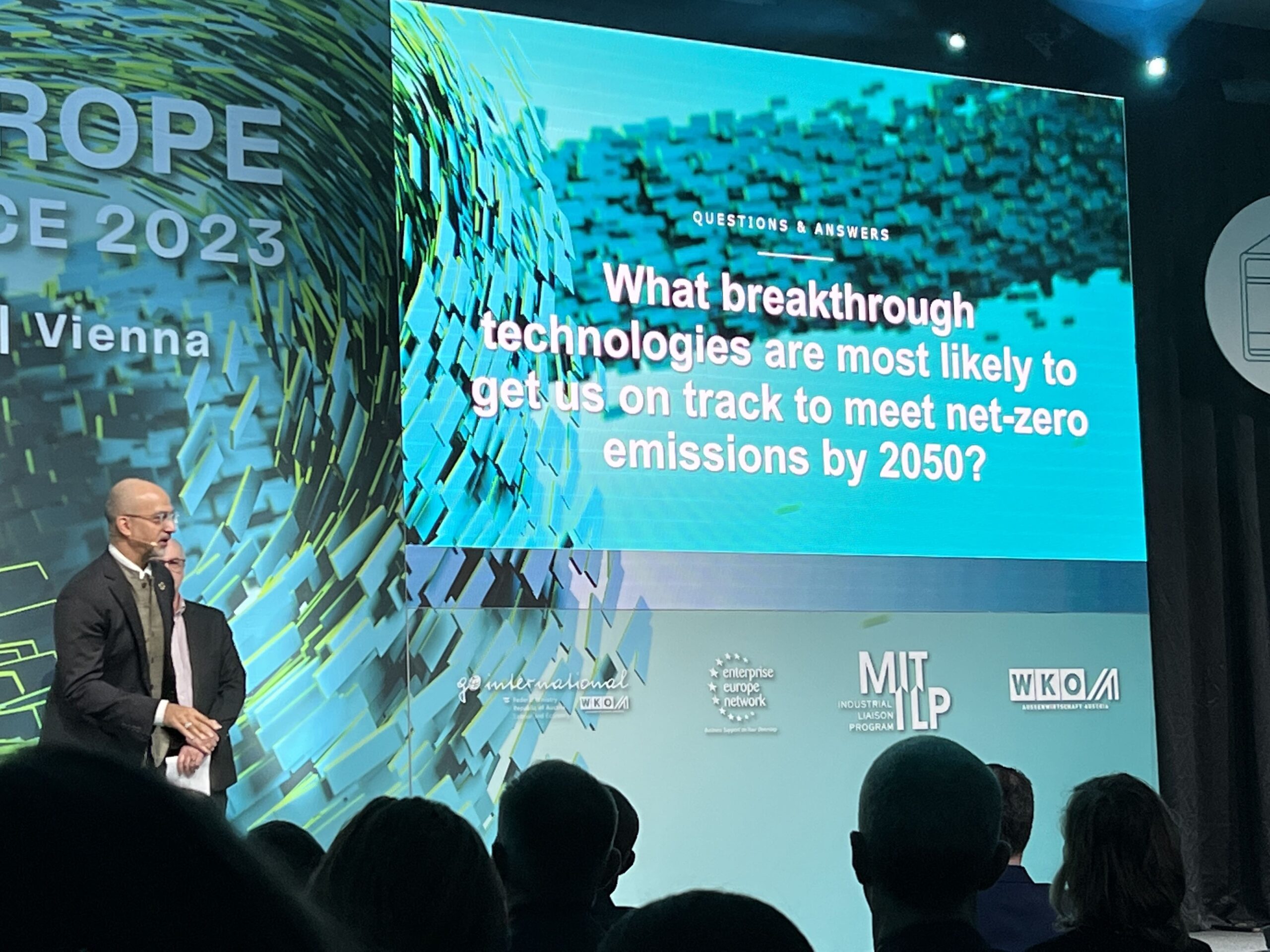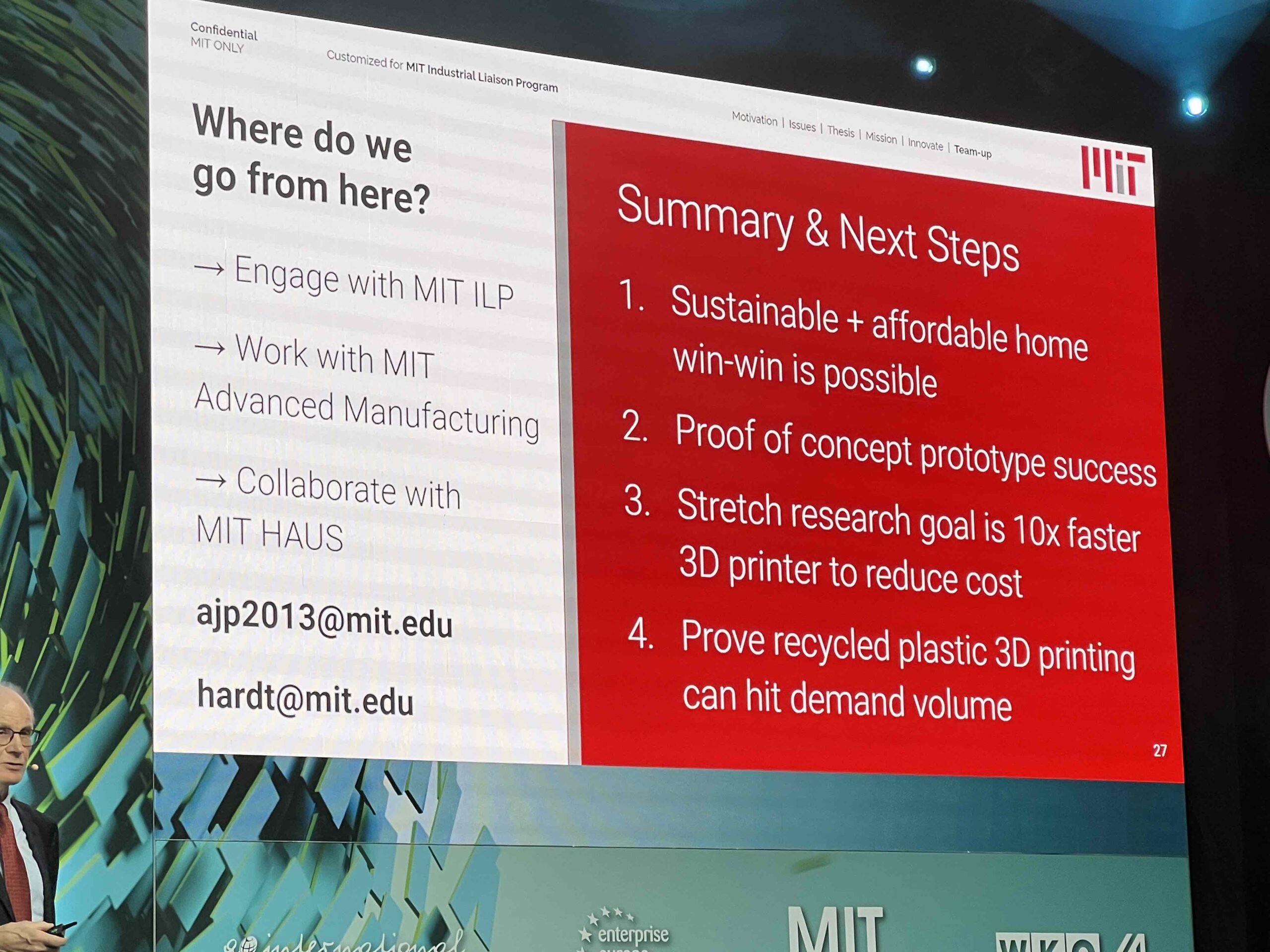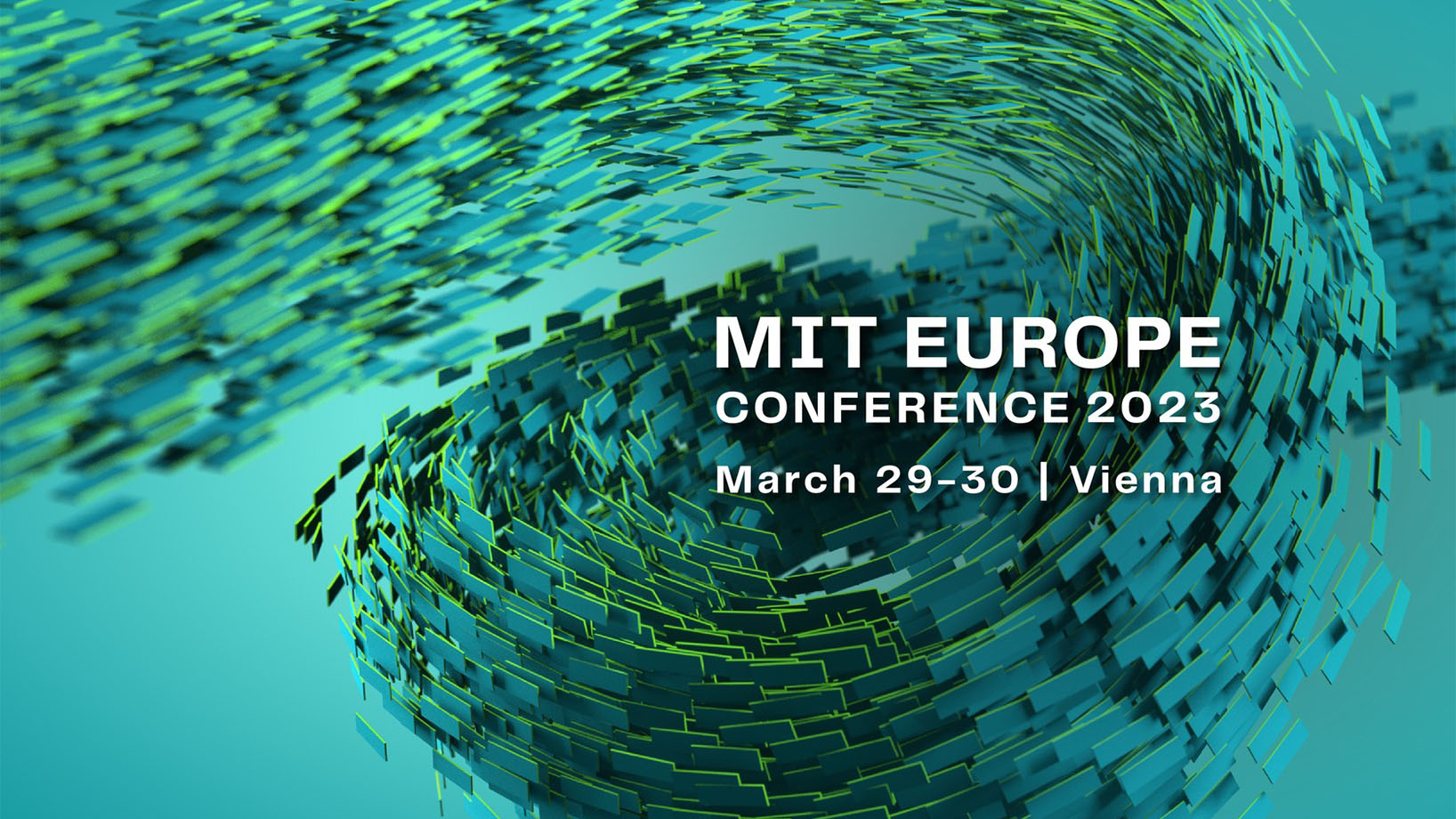Key takeaways:
- 7% yearly emission savings needed for climate goals; 2% achieved during lockdowns.
- Microbes as sensors for pathogen detection.
- Metal-organic frameworks (MOFs) for energy storage.
- Advancing wireless sensing for looking through walls.
- Cheap IoT sensors for ocean exploration.
- Upcycling PET bottles to create 3D-printed, eco-friendly housing solutions for the homeless.
Key takeaways:
- 7% yearly emission savings needed for climate goals; 2% achieved during lockdowns.
- Microbes as sensors for pathogen detection.
- Metal-organic frameworks (MOFs) for energy storage.
- Advancing wireless sensing for looking through walls.
- Cheap IoT sensors for ocean exploration.
- Upcycling PET bottles to create 3D-printed, eco-friendly housing solutions for the homeless.
VIENNA – The Austrian Federal Economic Chamber (WKO) successfully hosted the ninth annual MIT Europe Conference 2023 in Vienna at the end of March. The event brought together renowned scientists from the Massachusetts Institute of Technology (MIT), as well as international representatives of startups, to discuss cutting-edge technological advancements and their potential impact on various industries.
With around 300 participants attending the conference in person, the event also attracted several hundred technology enthusiasts from around the world, who joined via a live moderated stream. This virtual participation enabled a broader audience to gain insights into the work of the prestigious US think tank, MIT.

The conference featured a diverse range of topics, including artificial intelligence, robotics, biotechnology, renewable energy, and digital innovation, among others. The event aimed to foster collaboration and knowledge exchange between researchers, startups, and industry leaders in order to advance technology development and adoption across Europe.
Participants had the opportunity to engage in workshops and interactive sessions, enabling them to not only learn from MIT’s leading researchers but also network with like-minded professionals from various sectors.
Problems and Opportunities
“Every problem is an opportunity,” said John Fernández, a professor of architecture at MIT, who highlighted species extinction and climate change as the most pressing challenges of our time. Fernández stressed the importance of innovative solutions that can act as a catalyst for a carbon-neutral future. These solutions involve resource-conserving and energy-efficient planning and design of buildings and cities.
To address these global issues, Fernández encouraged collaboration between researchers, architects, urban planners, policymakers, and other stakeholders. By integrating sustainable technologies and eco-friendly practices into urban planning and architectural design, we can create more resilient and environmentally responsible cities.

Some examples of innovative approaches include designing energy-efficient buildings that harness renewable energy sources, incorporating green spaces and natural elements in urban areas to mitigate the heat island effect, and promoting sustainable transportation alternatives to reduce greenhouse gas emissions.
Professor Fernández’s perspective highlights the importance of viewing challenges as opportunities for change and progress. By fostering a culture of innovation and collaboration, we can work together to develop and implement solutions that will contribute to a more sustainable and carbon-neutral future for our planet.
Microbes as Pathogen Detectors
Chemist Ariel Furst, from MIT’s Department of Chemical Engineering, is conducting groundbreaking research on utilizing microbes as pathogen detectors. These microbes can function as electrical sensors, and can be programmed according to specific requirements, offering a novel and versatile approach to pathogen detection.
Furst’s research has primarily focused on testing these microbial sensors for detecting human papillomavirus (HPV) and respiratory infections. The promising results from these initial tests have paved the way for expanding the application of this method to a wider range of infectious diseases.
By harnessing the natural abilities of microbes to sense and respond to environmental changes, Furst and her team are developing a cutting-edge approach to disease detection and diagnostics. This technology has the potential to revolutionize healthcare by offering rapid, accurate, and cost-effective detection methods, which can lead to early diagnosis and timely treatment of various infectious diseases.
In the long term, the development of these microbial sensors could contribute to improved public health by enabling faster outbreak identification and containment. Additionally, the technology could be used in various industries, such as agriculture and food safety, to monitor and detect harmful pathogens that may pose risks to human health.
As Ariel Furst and her team continue to advance this innovative research, the potential applications and benefits of microbes as “sniffer dogs” for detecting pathogens are becoming increasingly apparent, highlighting the transformative power of science and technology in addressing global health challenges.
Metal Organic Frameworks – Super Sponges
Chemist and materials scientist Mircea Dincă is at the forefront of research on materials that can collect and store energy to develop resource-efficient batteries and sustainable cooling technologies. During the MIT Europe Conference 2023 in Vienna, Dincă discussed metal-organic frameworks (MOFs), which function like sponges and have the potential to make materials and processes more energy-efficient.
MOFs are porous materials composed of metal ions or clusters connected by organic linkers. Their unique structures result in an extraordinarily large surface area, which enables them to adsorb and store gases, as well as other substances, within their pores. This sponge-like quality has attracted significant interest from researchers and industry professionals, who are exploring various applications for MOFs.
One of the most promising applications of MOFs is in the field of energy storage and conversion. Dincă’s research is focused on harnessing the properties of MOFs to create more efficient batteries, which could have a significant impact on the performance and sustainability of electric vehicles and renewable energy systems. In addition, MOFs have the potential to be used in sustainable cooling technologies, such as adsorption-based refrigeration systems, which could reduce the reliance on conventional, energy-intensive cooling methods.
Besides energy storage and cooling, MOFs have also been explored for other applications, such as carbon capture, drug delivery, and catalysis. The versatility of these materials makes them a promising avenue for research and technological development.
As Mircea Dincă and his colleagues continue to study and innovate with MOFs, these super sponges have the potential to revolutionize various industries by offering more sustainable and energy-efficient solutions. By integrating MOFs into existing and emerging technologies, we can create a more environmentally friendly future.
Sensing the World
Fadel Adib, an Associate Professor at MIT, is a pioneer in the field of wireless sensing research. His work is centered on capturing, connecting, and perceiving the physical world in groundbreaking ways. Alongside his team, Adib is developing innovative technologies that have the potential to reshape our understanding of the world around us and offer novel solutions to a range of challenges.
One of the key innovations from Adib’s research is the development of wireless and sensor technology capable of seeing through walls. This technology works by emitting wireless signals and analyzing the reflections from various objects and people inside a room, creating a real-time, high-resolution image of the scene. Applications of this technology range from search and rescue operations in disaster scenarios to remote monitoring of elderly patients and security applications.
In addition to this breakthrough, Adib’s team is also working on an Internet of Things (IoT) system aimed at surveying the still largely unexplored oceans, which comprise approximately 95 percent of the Earth’s waters. By employing cutting-edge sensor technology and IoT systems, they hope to gather vital information about marine ecosystems, monitor climate change impacts, and discover new resources and species in the deep sea.
Fadel Adib’s research is pushing the boundaries of wireless sensing technology and paving the way for innovative applications that were once thought to be impossible. These advancements have the potential to revolutionize various sectors, from environmental conservation to healthcare and public safety. By developing new ways of looking at the world, Adib and his team are contributing to a more connected and better-understood future.
Housing the Homeless
David Hardt, a professor in MIT’s Department of Mechanical Engineering, is collaborating with researcher and founder AJ Perez on an innovative project aimed at providing homeless people with “dignified, affordable, and sustainable” housing solutions. Their approach involves upcycling PET bottles, which are commonly used for packaging beverages, and converting them into eco-friendly building materials for constructing affordable homes.
The process begins with collecting and recycling PET bottles, which are then transformed into a suitable material for 3D printing. By utilizing advanced 3D printing technology, Hardt and Perez’s team can create customized, durable, and cost-effective housing units that are specifically designed to meet the needs of homeless individuals and families.

This upcycling method offers several benefits, including reducing plastic waste in landfills and oceans, lowering the environmental impact of traditional construction materials, and providing affordable housing options to those in need. Furthermore, by leveraging 3D printing technology, Hardt and Perez can rapidly construct these homes, making it a feasible solution for addressing the growing problem of homelessness in many communities worldwide.
David Hardt and AJ Perez’s innovative approach to upcycling PET bottles and creating sustainable housing showcases the potential of combining recycling initiatives with advanced technologies to address pressing social and environmental issues. By giving homeless people access to affordable, eco-friendly housing options, they are not only improving individual lives but also contributing to a more sustainable and compassionate society.
Österreichbezug
On the Austrian side, the MIT Europe Conference 2023 featured prominent local experts who shared their research work and developments in various fields. Gernot Grömer, an astrophysicist and analog astronaut at the Austrian Space Forum (ÖWF), discussed advancements in space exploration and the potential applications of space technology in addressing global challenges. Wilfried Steiner, the Director of TTTech Labs, shared insights into cutting-edge research on dependable networking and safety controls for the transportation, aerospace, and industrial sectors. Hugo Furtado, the CEO of Dreamwaves, showcased the company’s developments in immersive audio technologies that enhance user experiences in virtual reality, gaming, and multimedia applications.
Conclusion
The conference gave us at keyper the opportunity to learn from MIT’s experts, who shared their latest research findings and groundbreaking innovations in various fields, including artificial intelligence, robotics, biotechnology, renewable energy, and digital innovation. By engaging with these thought leaders, we can stay abreast of emerging trends and technologies that may potentially impact their key management solutions or offer new opportunities for product development and enhancement.
Furthermore, MIT Europe Conference 2023 provided an excellent platform for networking with other industry professionals and startups. By fostering relationships with like-minded individuals and companies, we will explore potential partnerships, collaborations, or business opportunities that may contribute to our growth and expansion. Engaging with others in the industry also allowed us to exchange ideas and learn from the successes and challenges of other organizations.
Overall, the MIT Europe Conference 2023 emphasized the importance of international collaboration in addressing global challenges and shaping the future of technology. By attending the event, we from keyper demonstrated our commitment to being part of the global conversation on technology development and innovation, and our dedication to contributing to a more sustainable and technologically advanced future.
